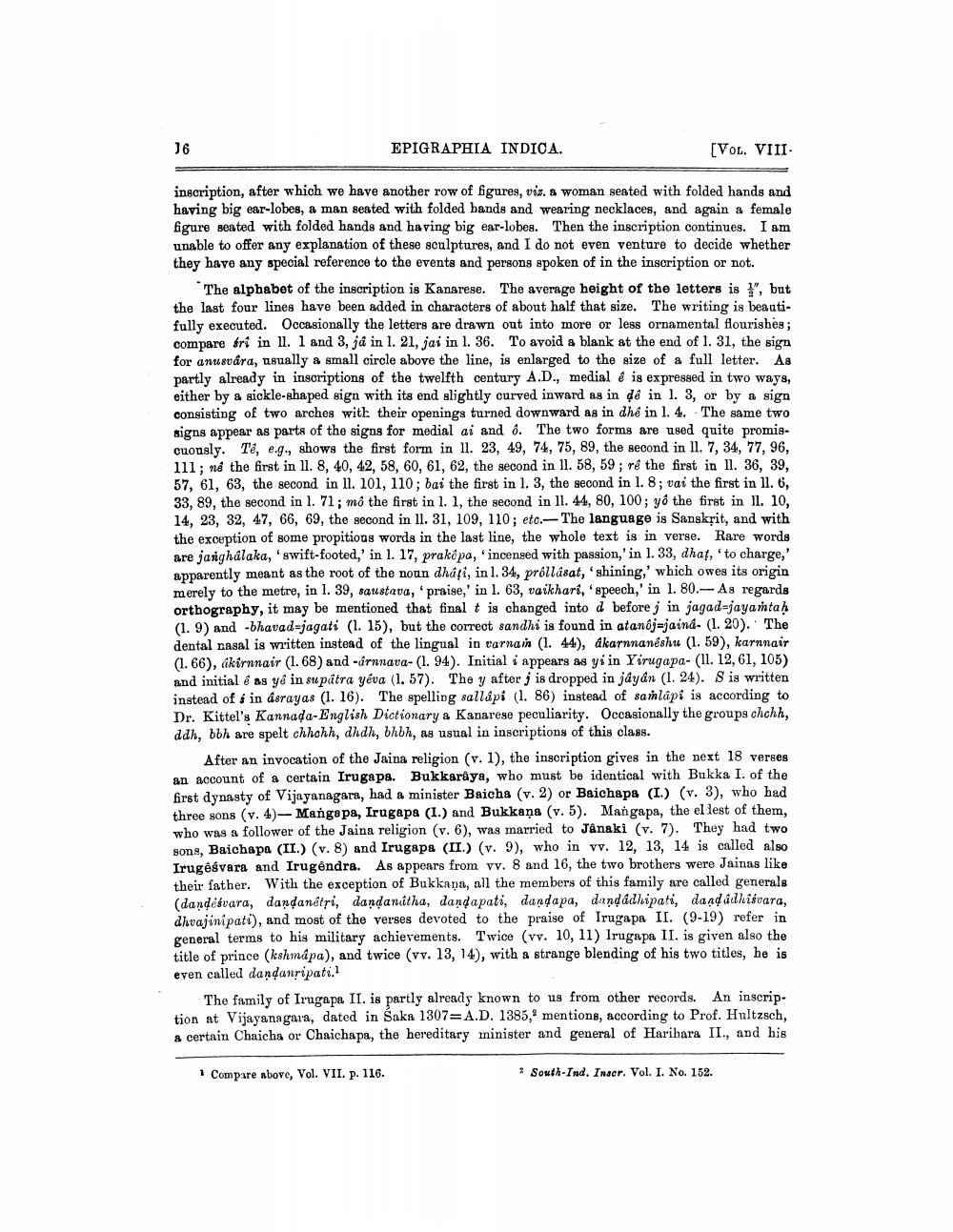________________
36
EPIGRAPHIA INDICA.
[VOL. VIII
inscription, after which we have another row of figures, viz. a woman seated with folded hands and having big ear-lobes, a man seated with folded hands and wearing necklaces, and again a female figure seated with folded hands and having big ear-lobes. Then the inscription continues. I am unable to offer any explanation of these sculptures, and I do not even venture to decide whether they have any special reference to the events and persons spoken of in the inscription or not.
The alphabet of the inscription is Kanarese. The average height of the letters is ", but the last four lines have been added in characters of about half that size. The writing is beautifully executed. Occasionally the letters are drawn out into more or less ornamental flourishes; compare śr in 11. 1 and 3, já in 1. 21, jai in 1. 36. To avoid a blank at the end of 1. 31, the sign for anusvára, usually a small circle above the line, is enlarged to the size of a full letter. As partly already in inscriptions of the twelfth century A.D., medial é is expressed in two ways, either by a sickle-shaped sign with its end slightly curved inward as in dê in 1. 3, or by a sign consisting of two arches with their openings turned downward as in dhe in 1. 4. The same two signs appear as parts of the signs for medial ai and ô. The two forms are used quite promiscuously. Té, e.g., shows the first form in 11. 23, 49, 74, 75, 89, the second in II. 7, 34, 77, 96, 111; ne the first in 11. 8, 40, 42, 58, 60, 61, 62, the second in 11. 58, 59; re the first in 11. 36, 39, 57, 61, 63, the second in 11. 101, 110; bai the first in 1. 3, the second in 1. 8; vai the first in 11. 6, 33, 89, the second in 1. 71; mô the first in 1. 1, the second in 11. 44, 80, 100; yo the first in 11. 10, 14, 23, 32, 47, 66, 69, the second in 11. 31, 109, 110; etc.-The language is Sanskrit, and with the exception of some propitious words in the last line, the whole text is in verse. Rare words are janghålaka, 'swift-footed,' in 1. 17, prakôpa, 'incensed with passion,' in 1. 33, dhat, 'to charge,' apparently meant as the root of the noun dhati, in 1. 34, prôllásat, shining,' which owes its origin merely to the metre, in 1. 39, saustava, praise,' in l. 63, vaikhari, 'speech,' in 1. 80.- As regards orthography, it may be mentioned that final t is changed into d before j in jagad-jayamtaḥ (1.9) and -bhavad-jagati (1. 15), but the correct sandhi is found in atanôj-jainá- (1. 20). The dental nasal is written instead of the lingual in varnam (1. 44), akarnnanêshu (1. 59), karnnair (1.66), akirnnair (1.68) and -árnnava- (1. 94). Initial i appears as yi in Yirugapa- (11. 12, 61, 105) and initial é as yê in supâtra yeva (1. 57). The y after j is dropped in jâyân (1. 24). S is written instead of in asrayas (1. 16). The spelling sallaps (1. 86) instead of samlapt is according to Dr. Kittel's Kannada-English Dictionary a Kanarese peculiarity. Occasionally the groups chchh, ddh, bbh are spelt chhohh, dhdh, bhbh, as usual in inscriptions of this class.
After an invocation of the Jaina religion (v. 1), the inscription gives in the next 18 verses an account of a certain Irugapa. Bukkaraya, who must be identical with Bukka I. of the first dynasty of Vijayanagara, had a minister Baicha (v. 2) or Baichapa (I.) (v. 3), who had three sons (v. 4)- Mange pa, Irugapa (I.) and Bukkana (v. 5). Mangapa, the ellest of them, who was a follower of the Jaina religion (v. 6), was married to Janaki (v. 7). They had two sons, Baichapa (II.) (v. 8) and Irugapa (II.) (v. 9), who in vv. 12, 13, 14 is called also Irugêsvara and Irugêndra. As appears from vv. 8 and 16, the two brothers were Jainas like their father. With the exception of Bukkana, all the members of this family are called generala (dandesvara, dandanêtri, dandanátha, dandapati, dandapa, dandadhipati, dandadhisvara, dhvajinipati), and most of the verses devoted to the praise of Irugapa II. (9-19) refer in general terms to his military achievements. Twice (vv. 10, 11) Irugapa II. is given also the title of prince (kshmapa), and twice (vv. 13, 14), with a strange blending of his two titles, he is even called dandanripati.l
The family of Irugapa II. is partly already known to us from other records. An inscription at Vijayanagara, dated in Saka 1307 A.D. 1385, mentions, according to Prof. Hultzsch, a certain Chaicha or Chaichapa, the hereditary minister and general of Harihara II., and his
1 Compare above, Vol. VII. p. 116.
"South-Ind. Inser. Vol. I. No. 152.




